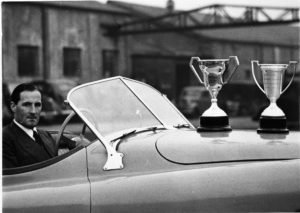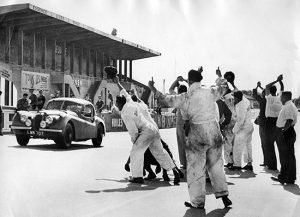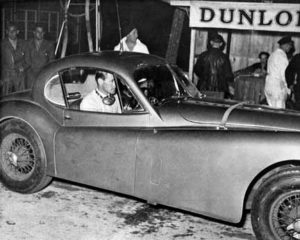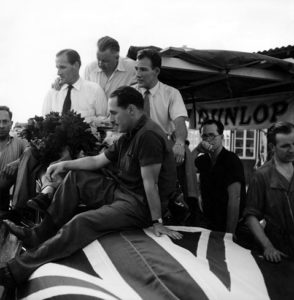Leslie George Johnson
Racing Driver and Architect of the Montlhéry Record Runs

Leslie Johnson in XK120 January 1950
In Jaguar circles, Leslie Johnson is generally known as one of the four drivers, and the one who came up with the idea, of the XK120 FHC – LWK 707 – that was driven round the track at Montlhéry at over 100 mph, 24 hours a day for a whole week in August 1952. More importantly he was the first driver to race the new Jaguar XK120, winning races both at home and in the US and drove for Jaguar on many other occasions up to 1953.
This article only deals with his time and efforts with Jaguar, the rest of his career is well documented elsewhere.
Leslie Johnson was born on 22 March 1912 in Walthamstow, North East London, at that time one of London’s poorest districts, and he spent his early years there. His father, a cabinet maker, died soon after starting his own business. Johnson, left with a mother and younger brother to support even though he was still in his teens, took charge of the firm. The employees responded to his management style with a loyalty and dedication which, allied to Johnson’s astute business brain, helped create the successful furniture manufacturing business that funded his entry into motor sport.
His competition career started in the 1930s when he rallied a BMW 328 but this stopped with the outbreak of war.
Among his close friends was Jaguar founder William Lyons (to whom he lent his BMW 328 for detailed mechanical investigation during the post-war planning and design of the XK120).
When competition resumed after World War II, he progressed from rallies to hill climbs, sports car racing and single-seaters. Although a prodigiously gifted driver he never made a full commitment to racing, business interests remained his primary focus.
Highlights of his Jaguar Driving Career
Johnson’s involvement in motor sport began and ended with rallying, and he was a member of the Rootes factory team but also rallied an XK120 before progressing to sports car racing. Johnson’s early races were with his BMW 328 and a Talbot-Lago T150C before going on to Aston Martins and Jaguars. He achieved Aston Martin’s first postwar international victory in 1948, and then the first successes for the XK120 in both England and America.
In 1950 Johnson, partnered with Bert Hadley, entered his XK120 for the Le Mans 24 hour race, having raced there in 1949 driving an Aston Martin. This was one of three private entries that year of the new Jaguar XK120. Although Johnson / Hadley retired with clutch problems 23 hours into the race, after completing 220 laps, the other two XK120s finished 12th and 15th. Had their clutch not failed they were on target for finishing 13th behind Peter Clark and Nick Haines in their XK120. This was a good result for Jaguar, proving that the XK engine and running gear was inherently reliable, even if the car itself wasn’t either designed to race, nor quick enough to win.
His name is closely associated with Jaguar, particularly the XK120. The extraordinary competition history of his white car, road-registered as JWK 651, made it the world’s most valuable XK120 when it sold at auction in 2001 for £230,000 ($350,000).
Race Results- Jaguar Related
|
Year |
Date |
Race |
Result |
Car / Co-driver |
Entrant / Team |
| 1939 | 1 July | Crystal Palace His first race |
5th | Frazer Nash | L. G. Johnson |
| 1948 | 11 July | Spa 24 Hours, Belgium His first win and Aston Martin’s first postwar victory. |
1st | Prototype Aston Martin with John Horsfall | Aston Martin |
| 1949 | 26 June | Le Mans, France 24 hours Johnson’s first Le Mans race |
DNF | Aston Martin DB2 with Charles Brackenbury | Aston Martin |
| 20 August | Silverstone Daily Express International Sports Car Race The XK120’s first race |
1st | Jaguar XK120 HKV 500 |
Leslie Johnson | |
| 1950 | 3 January | Palm Beach Shores, Florida SCCA Sports Car Race The XK120’s first American race |
4th | Jaguar XK120 | |
| 23 April | Mille Miglia, Italy | 5th | Jaguar XK120 with John Lea |
Jaguar Cars Ltd | |
| 25 June | Le Mans 24 hours |
DNF (retired 23rd hour, 220 laps) |
Jaguar XK120 660040 with Bert Hadley | ||
| 26 August | Silverstone 1 hour |
8th | Jaguar XK120 | ||
| 16 September | Dundrod, Northern Ireland Tourist Trophy |
7th | Jaguar XK120 | ||
| September | Montlhéry, Paris 24 hour record run. The first time a production car had averaged over 100 mph for 24 hours. |
107.46 mph for 24 hours |
Jaguar XK120 with Stirling Moss |
||
| 1951 | 29 April | Mille Miglia, Italy | DNF | Jaguar XK120 with John Lea |
|
| 5 May | Silverstone Sports Car Race |
5th | Jaguar XK120 | ||
| 24 June | Le Mans 24 Hours |
DNF | Biondetti Special with Clemente Biondetti |
||
| 15 September | Dundrod, Northern Ireland Tourist Trophy |
4th | Jaguar C-type with Duncan Hamilton |
Jaguar Cars Ltd | |
| September | Montlhéry, Paris 1 hour record breaking run. |
131.83 miles in one hour |
Jaguar XK120 | ||
| 1952 | 5 April | RAC Rally – 3rd but later disqualified after a protest for running without rear spats, despite the scrutineers having noted and agreed their removal. | 3rd | Jaguar XK120 | |
| 2 June | Monaco Grand Prix |
DNF | Jaguar C-type with Duncan Hamilton |
Jaguar Cars Ltd | |
| 6 to 12 August | Montlhéry, Paris Record breaking run. First car to run at over 100 mph for 7 days and 7 nights |
100.31 mph for 7 days and 7 nights | Jaguar XK120 FHC LWK 707 with Stirling Moss, Bert Hadley and Jack Fairman |
||
| 1953 | 26 April | Mille Miglia, Italy | DNF | Jaguar C-type with W. A. Mackenzie |
|
| 1954 | 25 January | Monte Carlo Rally During the rally Johnson suffered a heart attack. |
Team Prize – Winner | Sunbeam-Talbot Mark IIAs with Stirling Moss and Sheila van Damm |
1952 Montlhéry XK120 24/7 Record Run In Detail
Following his efforts in the 1950 Le Mans 24 hour race with his XK120, Jaguar developed the XK120C (C-Type) to race at Le Mans in 1951 – winning first time out. For 1952 Jaguar modified the cars to try and gain some extra speed but all three C-Types failed with overheating problems.
Leslie Johnson decided another record attempt at Montlhéry would be good publicity and suggested they go ‘flat out for the week’. He persuaded William Heynes to release a car from the Experimental Department – a bronze coloured XK120 FHC. This was the second right-hand drive coupé made, LWK 707 and was fitted with long range fuel tanks to minimise the number of stops, an additional windscreen wiper to improve visibility when high on the banking and a two way radio.
Stirling Moss recalled:

1952 Montlhery, The Pit Crew
and XK120 FHC LWK 707
“…in mid-summer Leslie Johnson had another of his ideas. Having averaged 100 mph for 24 hours at Montlhéry he now talked Jaguar into attempting 100 mph for a week!…We again drove in three-hour spells. The speedbowl lap was under a minute at 120mph, so it was quite a strain. After each straight we hit the banking high up near the lip, then plunged off, twice every fifty seconds, night and day. In each spell we would cover about 2,000 laps. It was impossible to keep one’s mind occupied on a job like that. We had a two-way radio which helped keep boredom at bay. We talked all the time, called each other names, even told stories. One dare not let the mind wander, because we were running within four feet of the banking lip at around 120 mph. One had to concentrate on something. I worked out how many million revs the engine made in a day, how many times the wheels turned, things like that.

1952 Leslie Johnson in the driving seat of LWK 707
The weather did not help; hot by day, cold at night. Night driving was a strain too, because we couldn’t afford the drain on the battery of extra lights. The headlights had to be set very high to let us see the top of the banking when we were on it, and this meant that on the short straights we could see nothing at all because the beams were playing in the air.
We hit several hares, rabbits and birds, and Leslie swore at one point that he’d seen a huge ten-foot tall figure in a long cloak, wearing a tall pointed hat, striding toward him along the verge. Next time round the figure had gone…it worried the life out of him for the rest of his stint. In fact I (Stirling Moss) had donned a Shell fuel funnel, pulled a tarpaulin around me and sat on Jack Fairman‘s shoulders as he strode along the verge. After Leslie had whizzed by we ran away and hid…All very childish, but good fun in the circumstances. Leslie then had an extraordinary idea to get his own back during one of my stints. I came whistling off the banking to find him sitting with Jack Fairman in the middle of the track, playing cards!
Then he took the pit signal board and put it out on the track, so that my natural line past the pits took me between it and the timekeeper’s hut. He was lounging beside the hut so I waved to him as I shot though the gap. Next time round the board had been moved closer to the hut. The gap was narrower, but I couldn’t leave the fast line so I shot through it again. Next time round, he’d moved the board closer still. Each lap he narrowed the gap which made me concentrate harder to pass through it. Eventually he gave in, and the board went back to its proper position, hung on the tent. At least it passed the time…”

1952 LWK 707 with drivers, Johnson, Hadley, Fairman (front) & Moss
Montlhéry’s concrete surface was rough, and the Jaguar broke a spring when it was already well into the run. No spare was carried on board. Regulations stipulated that an outside replacement would make the car ineligible for any further records beyond those already achieved before the repair.
Johnson drove nine hours to save the other drivers from added risk while the speed had to be maintained on the broken spring.
When finally he stopped to have it replaced, the car had taken the following records:
- World and Class C, 72-hour records at 105.55 mph
- World and Class C, four-day records at 101.17 mph
- Class C, 10,000 kilometre record at 107.031 mph
- World and Class C, 15,000 kilometre records at 101.95 mph
- World and Class C, 10,000-mile records at 100.65 mph
After the repair the car went on to complete the full seven days and nights, covering a total of 16,851.73 miles at an average speed of 100.31 mph.
LWK 707 is now owned by the Jaguar Daimler Heritage Trust and generally on display in either the Collection Centre, or the main Museum building at the British Motor Museum at Gaydon.
Retirement and Early Death
Johnson’s worsening heart condition forced permanent retirement from competition in 1954.
Alongside his racing, his business ventures included the acquisition of British racing car manufacturer English Racing Automobiles (ERA) in 1947. He raced ERAs from 1947 to 1950 and sold the company in 1952. He also initiated and negotiated Stirling Moss‘s first commercial sponsorship deal, with Shell.
Leslie Johnson died on 8 June 1959, aged 47, at Foxcote House, the family’s home in the village of Foxcote, Gloucestershire, England.
Author: Tony Merrygold
Race results from www.RacingSportsCars.com
© Text and Images – Jaguar Daimler Heritage Trust
Sources and Further Reading:
-
Parker, Chas and Porter, Philip, Jaguar C-Type: The Autobiography of XKC 051 (Porter Press International Ltd, 2017)
-
Porter, Philip and Page, James, Jaguar Lightweight E-Type: The Autobiography of 49 FXN (Porter Press International, 2017)
-
Roe, Geoff, Bert Hadley A Son of Birmingham: A Tribute (The Pre-War Austin Seven Club Ltd, 2013)
-
Grimsdale, Peter, High Performance: When Britain Ruled the Roads (Simon & Schuster UK, 2020)
-
Lord Montagu of Beaulieu and foreword by HRH Prince Michael of Kent, Jaguar (Quiller Press, 1997)
-
Mennem, Patrick, Jaguar: An Illustrated History (The Crowood Press Ltd, 1991)
-
Parker, Chas, Jaguar D-Type: Owners’ Workshop Manual – 1954 Onwards (All Models) (Haynes Publishing, 2017)
-
Whyte, Andrew, Jaguar: The Definitive History of a Great British Car (Patrick Stephens Limited, 1990)
-
Hull, Nick, Jaguar Design: A Story of Style (Porter Press International, 2015)
-
Berry, Robert, Jaguar: Motor Racing and the Manufacturer (Distributed by E.P. Dutton, 1978)
-
Porter, Philip, Jaguar: Sports Racing Cars (Bay View Books, 1995)
-
Clausager, Anders Ditlev, Le Mans (Littlehampton Book Services Ltd, 1982)
-
Skilleter, Paul, Norman Dewis of Jaguar: Developing the Legend (PJ Publishing Ltd, 2017)
-
Porter, Philip and Skilleter, Paul, Sir William Lyons: The Official Biography (Haynes Publishing, 2001)
-
Edwards, Robert, Stirling Moss: The Authorised Biography (Cassell & Company, 2001)
-
Porter, Philip, Stirling Moss: The Definitive Biography – Volume 1 (Porter Press International, 2016)
-
Bingham, Phillip, The All-American Hero and Jaguar’s Racing E-types (Porter Press International, 2020)
-
Wilson, Peter D., XJ13: The Definitive Story of the Jaguar Le Mans Car and the V12 Engine That Powered It (PJ Publishing, 2011)